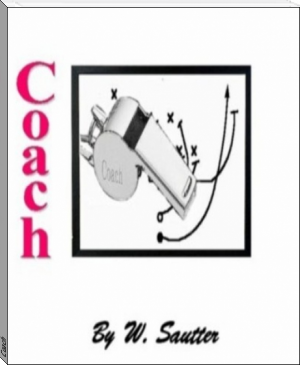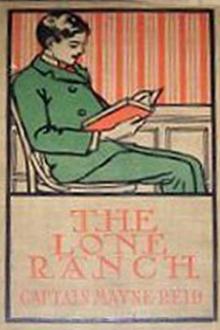The Young Voyageurs: Boy Hunters in the North, Mayne Reid [some good books to read .txt] 📗

- Author: Mayne Reid
Book online «The Young Voyageurs: Boy Hunters in the North, Mayne Reid [some good books to read .txt] 📗». Author Mayne Reid
Our voyageurs, having got on shore, first kindled a fire to cook their supper. This they intended to despatch earlier than usual, so as to give them the early part of the night for their swan-hunt, which they expected to finish before midnight. Lucien did the cooking, while Norman, assisted by Basil and François, made his preparations for the hunt. François, who was more interested in the result than any of them, watched every movement of his cousin. Nothing escaped him.
Norman proceeded as follows:—
He walked off into the woods, accompanied by François. After going about an hundred yards or so, he stopped at the foot of a certain tree. The tree was a birch—easily distinguished by its smooth, silvery bark. By means of his sharp hunting-knife he “girdled” this tree near the ground, and then higher up, so that the length between the two “girdlings,” or circular cuttings, was about four feet. He then made a longitudinal incision by drawing the point of his knife from one circle to the other. This done he inserted the blade under the bark, and peeled it off, as he would have taken the skin from a buffalo. The tree was a foot in diameter, consequently the bark, when stripped off and spread flat, was about three feet in width; for you must remember that the circumference of a circle or a cylinder is always about three times the length of its diameter, and therefore a tree is three times as much “round” as it is “through.”
They now returned to the camp-fire, taking along with them the piece of bark that had been cut off. This was spread out, though not quite flat, still leaving it somewhat curved. The convex side, that which had lain towards the tree, was now blackened with pulverised charcoal, which Norman had directed Basil to prepare for the purpose; and to the bark at one end was fastened a stake or shaft. Nothing more remained but to fix this stake in the canoe, in an upright position near the bow, and in such a way that the bottom of the piece of bark would be upon a level with the seats, with its hollow side looking forward. It would thus form a screen, and prevent those in the canoe from being seen by any creature that might be ahead.
When all this had been arranged, Norman shouldered the axe, and again walked off into the woods. This time his object was to obtain a quantity of “knots” of the pitch-pine (Pinus rigida), which he knew would most likely be found in such a situation. The tree was soon discovered, and pointed out to François, who accompanied him as before. François saw that it was a tree of about fifty feet in height, and a foot in diameter at its base. Its bark was thick, very dark in the colour, and full of cracks or fissures. Its leaves, or “needles,” were about three inches long, and grew in threes, each three forming a little bunch, bound together at its base by a brownish sheath. These bunches, in botanical language, are termed “fasciles.” The cones were somewhat shorter than the leaves, nearly of the shape of eggs, and clustered together in threes and fours. François noticed that the tree was thickly branched, and therefore there are many knots in the wood. For this reason it is not of much use as timber; but on account of the resin which it contains, it is the best species for firewood; and for that purpose it is used in all parts of the United States, where it grows. Most of the pine-wood sold for fuel in the large cities of America is the wood of this species.
François supposed that his companion was about to fell one of the trees. He was mistaken, however; Norman had no such intention; he had only stopped before one to examine it, and make sure that it was the species he was in search of. He was soon satisfied of this, and moved on, directing his eyes along the ground. Again he stopped; but this time it was by a tree that had already fallen—blown down, perhaps, by the wind. It was half decayed; but François could see that it was one of the same species—the pitch-pine.
This was the very thing Norman wanted, and plying his axe, he soon knocked out a large quantity of the resinous knots. These he at length collected, and putting them into a bag, returned with François to the fire. He then announced that he had no further preparations to make.
All four now sat down to supper, which consisted of dry meat, with biscuits and coffee; and, as their appetites were sharpened by their water journey, they made a hearty meal of it.
As soon as they had finished eating, the canoe was launched and got ready. The screen of birch-bark was set up, by lashing its shaft to the bottom timbers, and also to one of the seats. Immediately in front of this, and out upon the bow, was placed the frying-pan; and this having been secured by being tied at the handle, was filled with dry pine-knots, ready to be kindled at a moment’s notice. These arrangements being made, the hunters only awaited the darkness to set forth.
In the progress of their hunt they would be carried still farther down-stream; but as that was the direction in which they were travelling, they would only be progressing on their journey, and thus “killing two birds with one stone.” This was altogether a very pleasant consideration; and, having stowed everything snugly in the canoe, they sat chatting agreeably and waiting for the arrival of night.
Night came at length, and, as Norman had predicted, it was as “dark as pitch.” Stepping gently into the canoe, and seating themselves in their respective places, they pushed out and commenced floating down-stream. Norman sat near the bow, in order to attend to his torch of pine-knots. François was next to him, holding his double-barrel, loaded with buck-shot, which is the same size as that used for swans, and in England is even known as “swan-shot.”
Next came Basil with his rifle. He sat near François, just by the middle of the little vessel. Lucien, who was altogether a man of peace principles, and but little of a shot compared with either of his brothers, handled the oar—not to propel the canoe, but merely to guide it. In this way the party floated on in silence.
Norman soon kindled his torch, which now cast its red glare over the surface of the river, extending its fiery radii even to the banks on both sides of the stream. The trees that overhung the water seemed tinged with vermilion, and the rippling wave sparkled like liquid gold. The light only extended over a semicircle. From the manner in which the torch was placed, its light did not fall upon the other half of the circle, and this, by contrast, appeared even darker than it would otherwise have done.
The advantage of the plan which Norman had adopted was at once apparent to all. Ahead of the canoe the whole river was plainly seen for a distance of several hundred yards. No object larger than a cork could have floated on its surface, without being visible to those in the vessel—much less the great white body of a trumpeter swan. Astern of the canoe, on the other hand, all was pitchy darkness, and any one looking at the vessel from a position ahead could have seen nothing but the bright torch and the black uniform surface behind it. As I have already stated, the concave side of the bark was towards the blaze, and the pan containing the torch being placed close in to the screen, none of the light could possibly fall upon the forms of those within the canoe. They were therefore invisible to any creature from the front, while they themselves could see everything before them.
Two questions yet remained unanswered. First,—would our hunters find any swans on the river? Second,—if they should, would these birds allow themselves to be approached near enough to be shot at? The first question Norman, of course, could not answer. That was a matter beyond his knowledge or control. The swans might or might not appear, but it was to be hoped they would. It was likely enough. Many had been seen on the preceding day, and why not then? To the second question, the young Canadian gave a definite reply. He assured his cousins that, if met with, the birds would be easily approached in this manner; he had often hunted them so. They would either keep their place, and remain until the light came very near them, or they would move towards it (as he had many times known them to do), attracted by curiosity and the novelty of the spectacle. He had hunted deer in the same manner; he had shot, he said, hundreds of these animals upon the banks of rivers, where they had come down to the water to drink, and stood gazing at the light.
His cousins could well credit his statements. They themselves had hunted deer by torchlight in the woods of Louisiana, where it is termed “fire-hunting.” They had killed several in this way. The creatures, as if held by some fascination, would stand with head erect looking at the torch carried by one of the party, while the other took sight between their glancing eyes and fired the deadly bullet. Remembering this, they could easily believe that the swans might act in a similar manner.
It was not long until they were convinced of it by actual experience. As the canoe rounded a bend in the river, three large white objects appeared in the “reach” before them. A single glance satisfied all that they were swans, though, in the deceptive glare of the torch, they appeared even larger than swans. Their long upright necks, however, convinced the party they could be nothing else, and the canoe was headed directly for them.
As our hunters approached, one of the birds was heard to utter his strange trumpet-note, and this he repeated at intervals as they drew nearer.
“I have heard that they sing before death,” muttered François to Basil, who sat nearest him. “If so, I hope that’s the song itself;” and François laughed quietly at the joke he had perpetrated.
Basil also laughed; and





Comments (0)